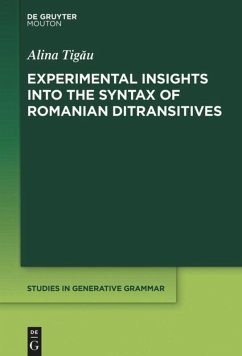This book investigates the syntax of Romanian ditransitives building on new experimental data with a view to enable a more accurate understanding of these constructions regarding their underlying configuration(s), the structural import of Differential Object Marking or Clitic Doubling among others.
One first attempt is to explain the (relatively) free word-order manifested by the two internal arguments, and their symmetrical potential for anaphor and possessor binding. Evidence is provided as to the relative hierarchical order of the two object DPs, with the direct object as the lower one.
The featural make-up of the two objects also proves crucial in disentangling the various experimentally uncovered aspects regarding their interaction e.g., differentially marked direct objects bear a [Person] feature and compete with the indirect object in valuing the person feature of the applicative. The feature specification is further refined function of the presence of clitic doubling or the lack thereof.
The experimental insights we gain into the syntax of Romanian ditransitives help us integrate them with their counterparts in Romance thereby contributing to a better cross-linguistic understanding of these constructions.
One first attempt is to explain the (relatively) free word-order manifested by the two internal arguments, and their symmetrical potential for anaphor and possessor binding. Evidence is provided as to the relative hierarchical order of the two object DPs, with the direct object as the lower one.
The featural make-up of the two objects also proves crucial in disentangling the various experimentally uncovered aspects regarding their interaction e.g., differentially marked direct objects bear a [Person] feature and compete with the indirect object in valuing the person feature of the applicative. The feature specification is further refined function of the presence of clitic doubling or the lack thereof.
The experimental insights we gain into the syntax of Romanian ditransitives help us integrate them with their counterparts in Romance thereby contributing to a better cross-linguistic understanding of these constructions.








